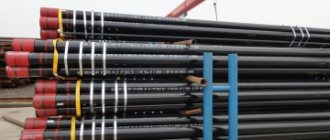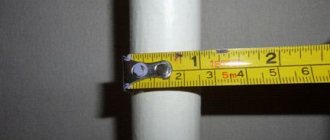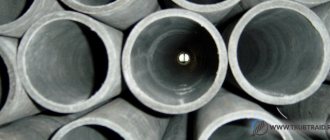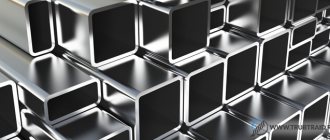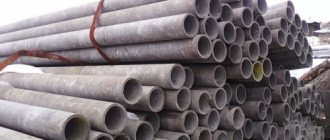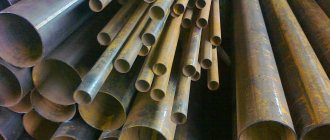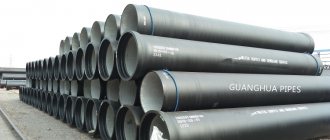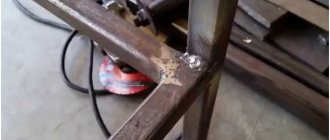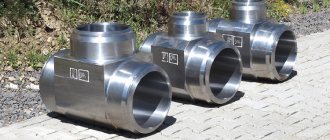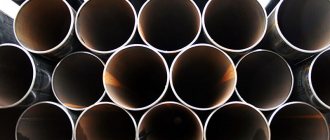GOST 8639 was published in 1982 to replace the document from ’68 and applies to cold-deformed and hot-deformed, electric-welded, cold-deformed and electric-welded seamless steel pipes having square or rectangular sections. The document presents a range of such products. Technical requirements for such pipes must fully comply with GOST 13663. The numerical values of the standards from 1982 and 1968 have slight differences.
The range of steel pipes in accordance with GOST 8639-82 includes products of both square and rectangular sections
The concept of assortment
What is this “assortment”?
The meaning of the word means a list of a specific product presented on the market or a list of products produced by a manufacturer. If we take profile pipes, the range of these products includes all types of products that are produced at enterprises or located in suppliers’ warehouses.
It is convenient to present the range of profile pipes in the form of tables. They contain information about the available types of steel and stainless steel profile pipes, among which square and rectangular parts are most often used for a wide range of products.
Profile is one of the main parameters of the parts presented in the table of a large assortment of profile steel pipes. In addition, it may indicate the steel grade, profile size, wall thickness of the products, yield strength, manufacturing method, and other characteristics, after reviewing which we have a complete understanding of the product.
GOST 13663 86
This State Standard presents profiled steel pipes of both seamless and welded types for general purpose. Various groups of carbon and alloy steel grades are used for manufacturing. The linear parameters of profile steel risers are recorded in special tables that can be easily found on the Internet.
Elements can be:
- with the presence of hollow ribs;
- flat oval shapes;
- oval and teardrop-shaped sections;
- square (GOST 8639);
- rectangular (GOST 8645).
The assortment provides for the presence of 2 groups of profile pipes in accordance with GOST:
- products of group A: the mechanical properties of steel are standardized;
- Group B products: the presence of chemical elements in a specific proportion and the mechanical characteristics of the base metal are standardized.
The index of the product group when marking it - A or B, is placed before the steel grades.
The assortment provides for the availability of steel profile pipes GOST 13663 86 with and without heat treatment.
Non-experts in this industry sometimes talk about the range of steel profile pipes GOST 13633 86. It turns out that such a Standard does not exist at all, and the numbers are probably simply mixed up and instead of 13663 they call 13633. That's all. So you need to be extremely careful and precise before talking about State Standards.
Let's focus on rectangular and square elements, which are more in demand in comparison with analogues of other sections.
Limit deviations of concavity and convexity according to GOST
The maximum deviations regarding the concavity or convexity of the sides, according to GOST, are given in the table.
Table 7
| Steel pipe | Maximum deviation characteristic of manufacturing accuracy | |
| High, *10-1 mm | Normal,*10-1 mm | |
| seamless hot-deformed up to 5 cm | 5 | 7,5 |
| seamless hot-deformed 5-7 cm | 8 | 10 |
| seamless hot-deformed 7-10 cm | 12 | 15 |
| seamless hot-deformed more than 10 cm | 15 | 20 |
| seamless cold-deformed and electric welded up to 5 cm | 5 | 5 |
| seamless cold-deformed and electric welded 5-7 cm | 5 | 7,5 |
| seamless cold-deformed and electric welded more than 7 cm | 8 | 10 |
Rectangular and square pipes have maximum torsional tolerances for high-precision products. For seamless hot-deformed and electric-welded, this value is 2 degrees per 1 meter. For cold-formed ones, the indicators are agreed with the consumer.
Rectangular pipes GOST 8645 68
As stipulated in the Standard and, accordingly, the range of profile rectangular parts, pipes can be produced:
- seamless method (hot and cold deformation);
- welding method (electric welding with hot and cold calibration, furnace welding).
As a type of profile rectangular pipe GOST 8645 68, square analogs of GOST 8639 82 are used in practice, the range of which is also quite large.
The shape of the rectangular elements should be the same as in the drawing. In Table 1 you can see the range of profile steel risers and some parameters of rectangular products for general purpose.
Table 1
| Section length | Section width | Wall thickness | Cross-sectional area | Weight 1 m | Moment of resistance | |
| mm | cm2 | kg | cm3 | |||
| 15 | 10 | 1 | 0,44 | 0,349 | 0,132 | 0,166 |
| 2 | 0,772 | 0,606 | 0,178 | 0,238 | ||
| 20 | 10 | 1 | 0,544 | 0,424 | 0,174 | 0,266 |
| 2 | 0,972 | 0,763 | 0,246 | 0,399 | ||
| 25 | 10 | 1 | 0,644 | 0,504 | 0,211 | 0,371 |
| 2 | 0,18 | 0,918 | 0,311 | 0,591 | ||
| 40 | 15 | 2 | 1,96 | 1,56 | 0,921 | 1,72 |
| 4 | 3,49 | 2,72 | 1,18 | 2,52 | ||
| 25 | 1,5 | 1,81 | 1,42 | 1,48 | 1,96 | |
| 4 | 4,29 | 3,37 | 2,82 | 3,82 | ||
| 60 | 30 | 1,5 | 2,58 | 2,01 | 2,72 | 4,01 |
| 5 | 7,56 | 5,95 | 6,18 | 9,87 | ||
| 40 | 1,5 | 2,86 | 2,26 | 3,91 | 4,86 | |
| 5 | 8,56 | 6,74 | 9,58 | 12,38 | ||
| 80 | 40 | 2,0 | 4,67 | 3,58 | 6,42 | 9,48 |
| 7 | 14,01 | 10,98 | 14,98 | 23,95 | ||
| 60 | 3,5 | 9,11 | 7,13 | 17,22 | 20,22 | |
| 7 | 16,81 | 13,18 | 27,82 | 33,31 | ||
| 180 | 80 | 7 | 33,61 | 26,38 | 89,43 | 145,2 |
| 12 | 54,27 | 42,51 | 125,8 | 214,1 | ||
| 150 | 8 | 49,24 | 38,67 | 228,8 | 253,4 | |
| 12 | 70,98 | 55,61 | 310,81 | 346,01 | ||
Production
Pipes can be produced either in a full cycle - from raw materials coming from a metallurgical plant, or from ready-made round pipes.
Electric welded pipes
According to GOST, a square pipe measuring from 10 to 100 millimeters with a wall thickness of 1-5 mm can be produced by electric welding.
The main stages of production of electric-welded steel pipe look like this:
- The steel sheet received at the enterprise in rolls is unwound, cut lengthwise and welded into an endless narrow strip. This is necessary to ensure continuous production;
- The narrow sheet entering the forming rollers is bent, turning into a round blank with an open seam;
- The seam is boiled;
Please note: There are several ways to weld the seam of an electric welded pipe.
Tungsten inert gas (TIG) welding is considered the most durable, but it is also the most expensive.
Fast and cheap welding using induction currents (HF) is used much more often.
- The workpiece is cooled with water and goes to the rollers for calibration. There, a round piece in cross-section turns into a square pipe;
- According to GOST, square electric-welded pipe undergoes mandatory quality control of the seam using eddy currents;
- After which it is cut into pieces of the required length, visually inspected again for geometry violations, and sent to the warehouse.
Electric-welded square pipes GOST 8639 82 are the cheapest and most common.
The production of welded pipes is technologically simpler compared to seamless pipes. But the lines are still impressive in size
Seamless pipes
Seamless square steel pipes GOST 8645 68 can be produced in two main ways:
- Cold deformation of the workpiece;
- Hot deformation.
To understand what the difference is, you will again have to turn to production technology.
- The rod - a cylindrical blank - is heated to a temperature at which the metal becomes plastic;
- After that, at the piercing mill, the press forms a sleeve from it - a hollow cylinder, from which a seamless pipe will be made;
- The sleeve enters the rollers, where it is stretched and acquires the desired diameter. It is the temperature at which the workpiece is deformed in the rollers that determines the type of pipe. Cold-deformed pipes are cooled with water before rolling. Hot-deformed ones remain hot and ductile .
This is how a round pipe with walls of the required thickness is formed from the sleeve
- Then the pipe, which already has the required wall thickness, enters the sizing rollers, where it is turned into a square.
- Next - again cutting into pieces, visual inspection and storage.
Important: according to GOST, square pipes produced by cold deformation undergo mandatory heat treatment.
The pipe is heated to the recrystallization temperature and cools down. This is necessary to get rid of the internal stresses of the metal.
Seamless square tubes:
- Stronger than electric welded ones;
- Can be manufactured with thicker walls;
- More expensive to produce.
According to GOST 8639 82, square pipes produced seamlessly can have the following dimensions:
- Cold-deformed - 10-120 mm with walls 1-8 mm thick;
- Hot-deformed square steel pipe GOST 8639-82 can have sizes from 60 to 180 mm with walls 4-14 mm thick.
The hot-deformed pipe undergoes all major technological operations under red-hot conditions.
Round pipe rolling
Just so you don't miss anything: a square pipe can also be made by simply rolling a finished round one.
Machines for this operation are sold, are not prohibitively expensive and do not even require stationary installation with pouring of the frame.
Of course, GOST does not provide for hand-made square pipes. At least due to the fact that without accurate calibration the product will not correspond to the range of profile pipes specified in the standard.
However, this production method exists and is in demand.
Important: semi-handmade pipes most often do not undergo final heat treatment after deformation, which is fundamentally wrong. Of course, strength and wear resistance suffer as a result.
A relatively simple machine profiles round pipes
Features of application
Risers are manufactured in close correlation between linear parameters and wall thickness. Thanks to the stiffening ribs, the design of rectangular parts is characterized by strength, reliability, long service life and other positive properties.
Rectangular risers are used in:
- construction industry. With their help, load-bearing structures are created for sports, cultural and mass facilities, offices, and other premises. Rectangular parts make ideal railings and various decorative fences;
- mechanical engineering. Modern tractors, agricultural machinery, heavy vehicles, trailers are mounted on frames made of hollow rectangular risers. Low weight combined with high strength is the main condition for creating reliable metal structures;
- agriculture. Constructed greenhouses, greenhouses, seed sheds, equipment, and other structures can easily withstand serious both transverse and longitudinal loads;
- furniture industry. There are such risers in every school desk, in every chair. They supply furniture for medical and public institutions. When combined with wooden elements, they look very aesthetically pleasing.
It is impossible to do without them when constructing the frames of trade pavilions, canopies, temporary and permanent advertising structures.
With their help, devices are installed that facilitate the performance of work indoors and outdoors.
Effective interaction with planes helps expand the range of applications of products. Thanks to the rectangularity of the structural parts, the range of functional purposes of the final product is significantly expanded.
Despite the savings in metal during production, rectangular risers are a fairly high-quality, sought-after product. Rectangular parts are available to consumers, which is associated with the competitive cost of the product and high quality.
Areas of use
GOST for square pipes, of course, does not dictate the scope of its application.
However, they follow from the very properties of the square pipe:
- A square pipe is stronger in bending than a round pipe;
- It has a smaller cross-section with the same wall thickness and specific gravity per linear meter.
If so, we will not see it in pipelines, but we will find it where mechanical strength is needed:
- Furniture frames;
- Canopies, cornices;
- Load-bearing metal structures of stadiums, shopping centers;
- Car frames;
- Greenhouse frames.
Here, for example, an unusual and durable staircase to the second floor was made from a square pipe
And then it came out with a beautiful and durable frame for sliding gates
GOST 8639 82
This Standard deals with the range of square profile pipes, for the manufacture of which the following are used:
- seamless method (hot- and cold-formed elements);
- electric welding (cold-deformed, hot-calibrated parts).
The document applies to the range of profile pipes GOST 8639 82 square section, for the production of which furnace welding was also used.
Depending on the manufacturing method, purpose, steel grades, parts can be of different lengths with different wall thicknesses, different sections and external dimensions (Table 2):
table 2
| Preparation method | External size, mm | Wall thickness, mm | Measured length, m | Unmeasured length, m |
| Seamless with hot forming | 60x60 – 180x180 | 4 – 14 | 4 – 12,6 | 4 – 12,6 |
| Seamless with cold deformation | 10x10 – 120x120 | 1 – 8 | 4,5 – 11 | 1,5 – 11 |
| Electric welded, electric welded with cold deformation | 10x10 – 100x100 | 0,8 – 5 | 5 – 9 | 1,5 – 11 |
| Electric welded with hot calibration | 100x100 – 180x180 | 4 – 14 | 5 – 9 | 1,5 –14 |
| Furnace welding | 40x40 – 70x70 | 3 – 5 | 4 – 8 | 4 – 8 |
The maximum error in total length is no more than +100 mm.
The drawing indicates the form, and the table. 3 for dimensions and other parameters of profile square pipes GOST 8639 82. Table 3
| External dimensions, mm | Wall thickness, mm | Cross-sectional area, cm2 | Weight 1 m, kg | Moment of resistance, cm3 |
| 10 | 0,9 | 0,316 | 0,245 | 0,851 |
| 1,4 | 0,447 | 0,351 | 0,101 | |
| 15 | 0,9 | 0,493 | 0,389 | 0,216 |
| 1,4 | 0,727 | 0,572 | 0,292 | |
| 20 | 0,8 | 0,605 | 0,475 | 0,369 |
| 1,5 | 1,072 | 0,842 | 0,601 | |
| 35 | 0,8 | 1,082 | 0,851 | 1,201 |
| 4,0 | 4,69 | 3,66 | 4,18 | |
| 50 | 2,0 | 3,74 | 2,98 | 5,73 |
| 8,0 | 12,33 | 9,68 | 13,89 | |
| 100 | 3,0 | 11,47 | 9,03 | 35,78 |
| 9,0 | 31,36 | 24,63 | 84,33 | |
| 180 | 8,0 | 53,93 | 42,33 | 292,68 |
| 14,0 | 89,58 | 70,34 | 449,26 |
Moments of inertia and resistance according to changes from '87, '89 and '92
The values of moments of inertia and resistance according to GOST 8639 in accordance with the changes (IUS 12 - 92, 2 - 90, 12 - 87) are presented in the table.
Table 9
| Pipe wall length, *102 mm | Wall thickness, *10-1 mm | Moment of resistance of the pipe, *10 cm3 | Moment of inertia, *10 cm4 |
| 0,1 | 8 | 0,0079 | 0,0039 |
| 9 | 0,0085 | 0,0042 | |
| 12 | 0,0100 | 0,0050 | |
| 14 | 0,0107 | 0,0053 | |
| 0,15 | 8 | 0,0196 | 0,0147 |
| 9 | 0,0215 | 0,0161 | |
| 12 | 0,0265 | 0,0199 | |
| 14 | 0,0293 | 0,0220 | |
| 0,20 | 8 | 0,0368 | 0,0368 |
| 9 | 0,0406 | 0,0406 | |
| 12 | 0,0510 | 0,0510 | |
| 14 | 0,0572 | 0,0572 | |
| 0,25 | 8 | 0,0592 | 0,0740 |
| 9 | 0,0656 | 0,0820 | |
| 12 | 0,0835 | 0,104 | |
| 14 | 0,0945 | 0,118 | |
| 0,30 | 8 | 0,0870 | 0,130 |
| 9 | 0,0966 | 0,145 | |
| 10 | 0,106 | 0,159 | |
| 12 | 0,124 | 0,186 | |
| 13 | 0,133 | 0,199 | |
| 14 | 0,141 | 0,212 | |
| 15 | 0,149 | 0,224 | |
| 0,35 | 8 | 0,120 | 0,210 |
| 9 | 0,134 | 0,234 | |
| 14 | 0,197 | 0,345 | |
| 15 | 0,209 | 0,365 | |
| 0,4 | 14 | 0,262 | 0,524 |
| 15 | 0,278 | 0,557 | |
| 0,45 | 20 | 0,457 | 1,029 |
| 0,50 | 20 | 0,574 | 1,436 |
| 25 | 0,691 | 1,727 | |
| 45 | 1,060 | 2,651 | |
| 0,60 | 20 | 0,848 | 2,545 |
| 25 | 1,027 | 3,081 | |
| 35 | 1,194 | 3,581 | |
| 0,70 | 30 | 1,670 | 5,845 |
| 35 | 1,895 | 6,634 | |
| 80 | 30 | 2,226 | 8,905 |
| 35 | 2,536 | 10,144 | |
| 90 | 4,941 | 19,766 | |
| 100 | 5,203 | 20,810 | |
| 110 | 5,416 | 21,664 | |
| 0,90 | 30 | 2,863 | 12,882 |
| 40 | 3,658 | 16,463 | |
| 1,00 | 30 | 3,579 | 17,895 |
| 40 | 4,594 | 22,971 | |
| 50 | 5,526 | 27,630 |
A special pipe size according to GOST of 55 mm has a moment of inertia of 27.10 cm4 and a moment of resistance of 9.85 cm³.
Determining the range of steel rectangular pipes according to GOST 8639-82 allows you to quickly select the necessary product designs, as well as establish and calculate their reliability parameters.
Assortment of square profile pipe GOST 30245 2003
This Standard specifies not only the parameters of square products, but also the technology for their production.
One of the main areas of application for such parts is capital construction.
For absolute confidence in the strength and reliability of structures, for their construction it is necessary to use only a range of steel profile pipes that comply with GOST.
The production of a wide range of profile square risers as a variety of rectangular products is carried out in accordance with GOST 30245 2003. The elements can be dimensional or non-dimensional. If necessary, you can purchase parts that are multiples of the measurements.
When cutting individual elements of finished products, enterprises adhere to the State Standard.
The document emphasizes that:
- the minimum length of parts cannot be less than 4 m, and the maximum - no more than 13 m;
- more often than others, buyers are interested in finished products with a length of 6 m and 12 m (it is precisely the elements with such linear parameters that can be found most often in construction stores);
- when cutting dimensional parts, it is necessary to adhere to maximum deviations of the order of up to 60 mm;
- the required length is determined by the customer, but it must be within the limits specified in the regulatory documents.
For products with a square cross-section, the Standard requires compliance with the length of the sides, the linear dimensions of which can range from 50 mm to 300 mm. The assortment of goods provides for the correspondence of the thickness of the element to its size. With an increase in the last parameter, the wall thickness should also increase (minimum value - 2 mm, maximum - 14 mm).
Some designs provide for the use of risers of non-standard sizes with the following parameters: cross-sectional area, wall thickness, length. Such elements must be tested. Produced parts must comply with the Technical Specifications of the state regulatory body, which assesses their safety level. The parts are marked with the TU designation.
The shape of the parts is indicated in the drawing.
Individual parameters of some product sizes can be found in table. 4.
Table 4
| h | b | t | Cross-sectional area, A cm2 | Weight 1 m, kg |
| mm | ||||
| 40 | 40 | 2 | 2,942 | 2,314 |
| 3 | 4,212 | 3,301 | ||
| 4 | 5,351 | 4,202 | ||
| 60 | 60 | 2 | 4,542 | 3,562 |
| 4 | 8,552 | 6,712 | ||
| 6 | 12,031 | 9,451 | ||
| 90 | 90 | 3 | 10,213 | 8,014 |
| 5 | 16,361 | 12,844 | ||
| 8 | 24,042 | 18,873 | ||
| 120 | 120 | 3 | 13,813 | 10,482 |
| 6 | 26,432 | 20,754 | ||
| 8 | 33,643 | 26,417 | ||
| 150 | 150 | 4 | 22,955 | 18,016 |
| 6 | 33,632 | 26,406 | ||
| 8 | 43,241 | 33,955 | ||
| 200 | 200 | 6 | 45,635 | 35,826 |
| 9 | 65,982 | 51,797 | ||
| 12 | 84,063 | 65,997 | ||
| 300 | 300 | 6 | 69,632 | 54,664 |
| 9 | 102,01 | 80,055 | ||
| 12 | 132,12 | 103,72 | ||
About performance characteristics and areas of application
The design of a square riser is a closed profile, for the formation of which a metal strip is used. The quality characteristics that appear during product operation depend on the design features and material of manufacture. These products are different:
- increased resistance to bending and torsion;
- strength;
- reliability;
- small weight;
- long service life.
Today it is difficult to imagine human activity without square risers. They have found wide application in various fields.
Profiles are the basis of modern industrial and domestic construction. When reconstructing old construction sites and constructing new ones, square-section parts are used to create roofing frames and floors.
It is impossible to imagine functioning without them:
- furniture industry (shelves, racks, chairs, tables, cabinets);
- mechanisms of the engineering industry;
- agriculture (sheds, garages, utility rooms, livestock farms);
- advertising business, other areas of human life.
Compared to analogs with a round cross-section, square and rectangular profiles bend after high loads. Moreover, after the load ceases, the riser takes its original position. This is their strength and reliability.
Round products, under a similar impact, can not only be deformed, but also completely collapse.
Production stages
The range of square steel profile pipes GOST 30245 2003 provides for the use of sheet steel grades from carbon and low-alloy groups with sheet thicknesses of 3 mm, 4 mm and higher. Individual orders are produced using high-quality rolled steel grades.
After determining the manufacturing method and product sections, production begins, which involves several stages:
- Unwinding and cutting rolled sheets into strips of a certain width.
- Forming a long strip from cut strips by welding.
- Feeding the tape, forming it into products with a square cross-section on a molding machine.
- Welding the connecting longitudinal seam formed as a result of bending the workpiece.
- Removal to a minimum (remaining no more than 0.5 mm - 1 mm) of flash from the weld.
- Carrying out control measures regarding the quality of welds. If deficiencies are found, they are removed.
- Cutting high-quality pieces of products of the required length.
- Packaging of finished elements.
Finished packaged products are sent to a warehouse for storage.
Application of square products
The definition of the assortment of steel square pipes by GOST 8639 (some changes were made in 1992) allows you to classify products and simplify the calculations of structural parameters when using them. The spread of profile pipes is explained by the favorable combination of strength and lightness.
Note! If there is a need, then it is permissible to produce products outside the range defined by GOST. In this case, the products must comply with the requirements of other regulatory documents.
They are used in the construction of enclosing structures, as supporting parts of external pipelines, metal roofing, and in the production of such products as frames, beams, stairs, and interfloor ceilings. In addition, products with a square (in many cases rectangular) cross-section are used in transport and industry.
Electric-welded pipes are made from flat billets, while seamless pipes are made from round ones.
Square steel pipes are the basis for a wide variety of elements and structures used in construction
How to calculate drainage
A properly functioning drainage system protects the roof, roofing, walls of the house, building base and foundation from premature wear. Not to mention the aesthetic component of the benefits of gutters.
They save you from dirt near the house, puddles near the basement and accidental falls. Let's consider the simplest questions about what the drainage system of a residential building should be like. What size should the downpipes be? The size of the pipes depends on what part of the country you live in, the average annual rainfall and the area of the part of the roof for which the drainage is calculated.
In a temperate climate, the calculation takes into account that a 1.5 cm² cross-section of the drain is sufficient to drain water from 1 m² of roofing. Based on this, a pipe with a diameter of 10 cm is capable of draining water from a roof area of about 53 meters.
What is the best material to use for gutters and downspouts?
The most common materials are aluminum and vinyl. But you can use steel and copper gutters. In this case, the determining factor may be the price of the product.
Installing copper gutters will be expensive, but with proper maintenance, these gutters will last for decades. If you live in an area with little temperature variation, vinyl gutters are a smart choice.
Seamless gutters or not?
Seamless gutters and gutters are the best option, according to experts. These gutters are made to specific dimensions. This type of gutters will cost more for the home owner. Precast gutters leak and sag over time. With any choice, it is advisable that the installation of gutters be carried out by a specialist in this field of construction.
Laying utilities
The construction of any facility, be it a residential apartment building or a production workshop, is not complete without the installation of communications that supply heat, water and gas to the building.
Considering the complexity and volume of this type of work, it would be advisable and profitable to contact specialists offering services in the field of laying and connecting utility lines of all types.
The use of carefully selected materials and modern equipment allows us to complete the work in the shortest possible time, guarantee its quality and offer customers the optimal price level for the services offered.

